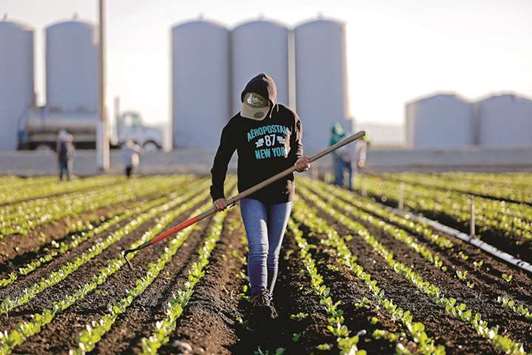Driscoll’s is so secretive about its robotic strawberry picker it won’t let photographers within telephoto range of it.
But if you do get a peek, you won’t see anything humanoid or space-aged. AgroBot is still more John Deere than C-3PO – a boxy contraption moving in fits and starts, with its computer-driven sensors, graspers and cutters missing 1 in 3 berries.
Such has been the progress of ag-tech in California, USA, where despite the adoption of drones, iPhone apps and satellite-driven sensors, the hand and knife still harvest the bulk of more than 200 crops.
Now, the $47 billion agriculture industry is trying to bring technological innovation up to warp speed before it runs out of low-wage immigrant workers.
California will have to remake its fields like it did its factories, with more machines and better-educated workers to labour beside them, or risk losing entire crops, economists say.
“California agriculture just isn’t going to look the same,” said Ed Taylor, a University of California at Davis rural economist. “You’re going to be hard-pressed to find crops grown as labour-intensively as they are now.”
Driscoll’s, which grows berries in nearly two dozen countries and is the world’s top berry grower, already is moving its berries to table-top troughs, where they are easier for both human and machines to pick, as it has done over the last decade in Australia and Europe.
“We don’t see – no matter what happens – that the labour problem will be solved,” said Soren Bjorn, president of Driscoll’s of the Americas.
That’s because immigrant farmworkers in California’s agricultural heartlands are getting older and not being replaced. After decades of crackdowns, the net flow across the US-Mexico border reversed in 2005, a trend that accelerated through 2014, according to a Pew Research Center study. And native-born Americans aren’t interested in the job, even at wages that have soared at higher than average rates.
“We’ve been masking this problem all these years with a system that basically allowed you to accept fraudulent documents as legal, and that’s what has been keeping this workforce going,” said Steve Scaroni, whose Fresh Harvest company is among the biggest recruiters of farm labour. “And now we find out we don’t have much of a labour force up here, at least a legal one.”
Stated bluntly, there aren’t enough new immigrants for the state’s nearly half-million farm labour jobs – especially as Mexico creates competing manufacturing jobs in its own cities, Taylor said. He has calculated that the pool of potential immigrants from rural Mexico shrinks every year by about 150,000 people.
Not surprisingly, wages for crop production have climbed 13 percent from 2010 to 2015 – a higher rate than the state average, according to a Los Angeles Times analysis of Labor Department data.
Growers who can afford it have begun offering savings and health plans more commonly found in white collar jobs. And they’re increasingly turning to foreign guest workers, recruiting 11,000 last year, which is a fivefold jump in just five years, The Times found.
None of that will solve the problem, economists say. Changing what they grow and how they grow it is all that’s left.
Response has been uneven, at best. Vast areas of the Central Valley have switched from labour intensive crops such as grapes or vegetables to almonds, which are mechanically shaken from the tree. The high-value grape industry has re-engineered the bulk of its vineyards to allow machines to span the vines like a monorail and strip them of grape clusters or leaves.
Fresno’s raisin industry, however, has a tougher problem to solve on a tighter profit margin. To fully mechanise, it may have to change not just its vineyard design, but the grape variety itself, much like the tomato industry developed a tough skinned Roma to withstand mechanical harvesters.
When labour shortages and price shocks hit in the early 2000s, growers altered vineyards so that machines could shake partially withered Thompson seedless grapes onto paper trays, a method that can slash more than 80 percent of labour costs, according to UC Davis researchers.
Eliminating trays entirely, however, requires a grape that can dry slowly on the vine before September rains hit. Thompsons mature too late. The Sunpreme, developed by a retired USDA plant scientist in California’s Central Valley, may soon be widely available, said Matthew Fidelibus, a UC co-operative extension adviser.
It may be too late to mechanise asparagus. The crop, among the most labour-intensive in the state, has gradually shifted to Mexico since trade barriers made it cheaper to grow there, casting a nostalgic pall over Stockton’s asparagus festival.
Last year, farmers in the Sacramento-San Joaquin River Delta area harvested only 8,000 acres of the signature spear, which is depicted on water tanks and town emblems throughout the region. In 2000, they harvested 37,000 acres, according to the US Department of Agriculture.
“We’re headed toward zero pretty soon,” said Cherie Watte Angulo, executive director of the California Asparagus Commission.
Grown on perennial beds that last a decade or so, asparagus must be selectively harvested every day during its 90-day season. Machines have utterly failed to duplicate human judgment and dexterity.
This season, a grower’s co-operative in the Stockton area tested a prototype harvester from Washington state that uses sensors to select only the mature stalks.
“I’ll keep it simple: the machine didn’t work,” said Bob Ferguson, who hosted the machine on his 162 acres of asparagus beds. “He took it back up to Washington.”
Even Driscoll’s AgroBot, among the more advanced prototypes in California fields, was picking only a bit more than half the ripe berries in its trials this spring in Camarillo.
“We think we are very close, but every day we try to make the next step. We see new things we need to solve,” said Juan Bravo, the Spanish inventor who is counting on Driscoll’s continued backing for his 10-year endeavour.
So far, the Watsonville, Calif., company is into AgroBot for the long-haul, said Michael Christensen, Driscoll’s research and development director, who watched Bravo tinker with the machine’s three dozen arms before setting it to another crawl.
Vertical rods slid left and right, guiding four-fingered graspers to precise coordinates set by a camera and computer. Soon, a stream of ripe berries emerged on a conveyor, mixed occasionally with green-tipped fruit. –TNS

Agricultural worker Alicia Solano thins rows of lettuce near Salinas, Calif., in March 2017. A computer-guided machine had done the bulk of the work, leaving her small crew to hoe only what it missed.


